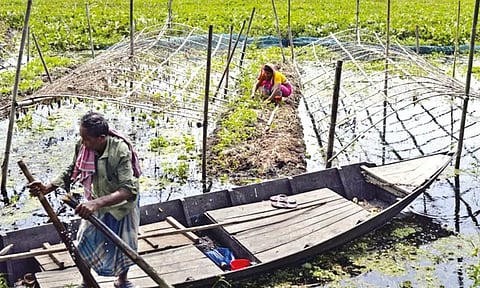

Bangladesh is a land of water. Its silty rivers rush down from the Himalayas, spill into a filigreed maze of ponds, wetlands and tributaries before emptying into the blustery, black Bay of Bengal.
Now, its most profound threat is water, in its many terrible incarnations: drought, deluge, cyclones, saltwater. All are aggravated to varying degrees by climate change, and all are forcing millions of people to do whatever they can to keep their heads above it.
This matters to the rest of the world, because what the 170 million people of this crowded, low-lying delta nation face today is what many of us will face tomorrow.
The people of Bangladesh are rushing to harvest rice as soon as they get word of heavy rains upstream. They’re building floating beds of water hyacinths to grow vegetables beyond the reach of floodwaters. Where shrimp farms have turned the soil too salty to cultivate crops, they’re growing okra and tomatoes not in soil, but in compost, stuffed into plastic boxes that had once carried shrimp. Where the land itself is washing away, people have to move to other villages and towns. And where they’re running out of even drinking water, they’re learning to drink every drop of rain. Saber Hossain Chowdhury, a governing party lawmaker and the prime minister’s climate envoy, compared his country’s efforts to plugging a leaky barrel. “It’s like when you have a drum that’s got seven leaks, and you’ve got two hands,” he said. “What do you do? It’s not an easy thing.”
Bangladesh has succeeded in saving lives during cyclones and floods. But there’s a host of other challenges to address, all at once: finding new sources of drinking water for millions along the coast, extending crop insurance, preparing cities for the inevitable influx of migrants from the countryside, even cultivating good relations with neighboring countries to share weather data. All this, with little help from the rich countries of the world. There’s mounting frustration in places such as Bangladesh that wealthy nations have not shored up the funds that developing countries need to adapt to the hazards they already face. It’s a theme of the Paris climate finance summit this week. Among the 64 districts of Bangladesh, half are considered to be vulnerable to climate change.
Floating gardens and a salty future
What do you do when the rivers swell and drown your crops? If you’re Shakti Kirtanya, you grow your crops on top of the water. If the water rises, they rise, too. They float and bob. “If you see the harvest, it will fill your heart with joy,” he said.
Kirtanya learned this farming technique from his father, who learned it from his. It has been practiced for 200 years in his low-lying district, Gopalganj, where land is usually inundated for half the year.
Now, because climate change is spreading the risk of flooding to many other areas, the floating gardens of Gopalganj are spreading. Over the past five years, the government has supported floating gardens in 24 of the country’s 64 districts.
Kirtanya uses what he has. He cuts the stems of water hyacinths in the lake near his house, lets the pile stew in the sun and shapes it into long, wide seedbeds on top of the water. He sows watermelon and amaranth in summer, cabbage and cauliflower in winter. The garden is a source of income and, for his family, a source of fresh produce grown without chemicals.
“Whether the rains are late or early, it doesn’t affect it,” Kirtanya said. “It doesn’t get hurt in the heat either.”
There is one looming threat. Seawater is coming farther inland. Partly it’s because of sea level rise, elevating the tides. Partly it’s because rivers have been dammed upstream, and not enough freshwater is flowing down. Partly it’s because too much groundwater is pulled up. Kirtanya saw a glimpse of a salty future last year. Leaves turned red. Plants became frail.
Sheela Biswas faces the crisis of salinity every single day. Salt has intruded into canals and ponds that her village relies on for drinking and washing. An estimated 30 million people who live along the coast face the problem of saltwater intrusion to varying degrees. The area where Biswas lives is among the worst hit. It wasn’t like this when she came as a bride 30 years ago. Then, most people ate rice that they grew on their land. They drank water they collected in their pond.
Then came “white gold”: shrimp. Shrimp farms spread. People let in saltwater through a canal from the river, so saltwater spread, too. Biswas’ pond turned too salty to drink.
First, she hired a cart to buy water. Then she turned to a neighbour who built an underground tank to collect rainwater. She invented her own rainwater-harvesting system with what she had at home, jiggering plastic pipes to channel rainwater from her tin roof through a fishing net and into earthen jars. She still had to bathe in her salty pond, which brought on a skin rash, a common complaint in the area. Doctors say rates of hypertension are high, too; they suspect their patients unintentionally ingest too much salt.
The latest solution to Biswas’ problem came in the form of a hot pink 2,000-liter plastic water tank, the equivalent of about 530 gallons, with a filter on top. It sits in her courtyard collecting the monsoon rains, one of nearly 4,000 such tanks distributed over the past three years by a development organization, BRAC, that assists the poor.
Unless global emissions are reduced quickly and dramatically, Bangladesh can do little to stay above the surface, said Chowdhury, the lawmaker. “Whatever we do is not going to be enough,” he said.
Sengupta is a journalist with NYT©2023
The New York Times